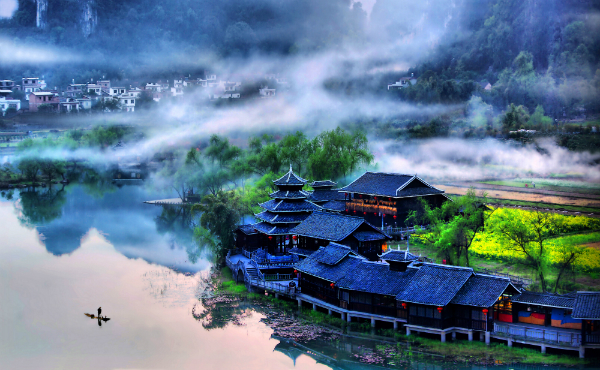

Guilin in southern China’s Guangxi province has long been South China’s most popular travel destination, acclaimed for its scenery of winding jade waters flanked by lurching Karst Mountains.
The iconic views are so revered by artists that Li River landscapes adorn China’s delegation at the United Nations and even her 20 yuan banknote.
Indeed, when Bill Clinton came here, he remarked: “There’s nowhere like Guilin. It reminds me of traditional Chinese paintings.”
But what is the best way to explore the Li River, and where do you start?
One wintery weekend in December, we reached Guilin by high-speed train from Hong Kong, then wrapped up and took to the Li River in search of an elusive ideal of Chinese landscape beauty.
Cruise on the Li River
The most popular way to enjoy the river scenery is to join the crowds on tourist boats from Guilin to the backpacker retreat of Yangshuo.
Ours came with a talkative guide who introduced highlights along the route as we took four or five hours to drift toward the backpacker nirvana of Yangshuo.
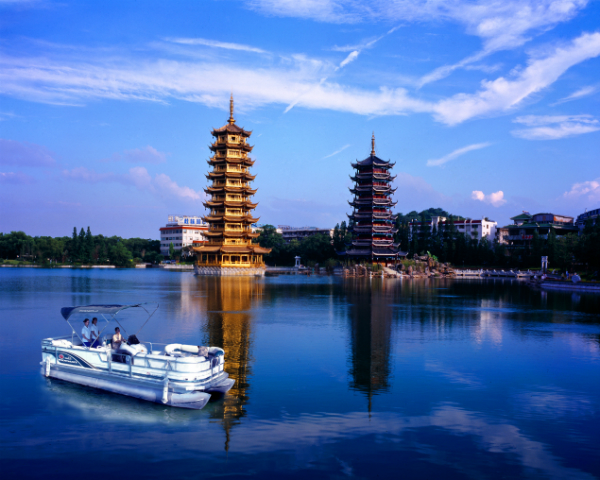
The river waters at year’s end looked brown and swollen. Once the boats got underway, we watched the passing scene from tables in the lower deck cabin while a basic lunch of spicy tofu and potato threads was served.
The best views, however, were from within the maelstrom of photographers on the upper deck.
Over the course of our journey a fantastic Karst landscape unfolded, reflected in the Li River’s limpid green waters.
The outer-skin of the limestone peaks have been washed away through millennia of water erosion, leaving a fairytale landscape of allusion.
So otherworldly is the scenery that this stretch of river was chosen as the location for the Wookie planet in the film Star Wars: Revenge of the Sith.
Many of the strange peaks along the way had names which our guide delighted in revealing.
Low on a cliff near the first bend of the river past the town of Yangdi leapt a large stone fish – the Li Fish. The fish with its reddish hue was only fleetingly visible from our big tourist barge, but the smaller crafts cast their lines close to it.
Further on, Divine Pen Peak, an outcrop suggestive of an ink pen jutted out from verdant green on the west bank of the river.
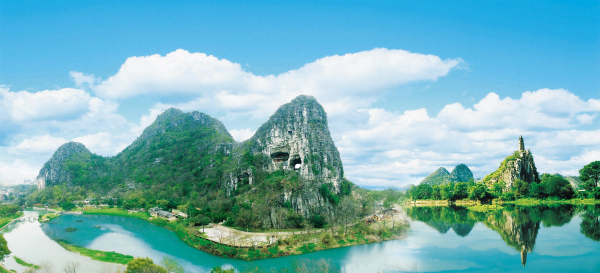
The biggest scenic hit with local tourists on this stretch of the river seemed to be Nine Horse Picture Hill.
This 100 meter high cliff, thanks to a combination of weathering and rock strata, supposedly resembles a painting of nine horses.
Our guide challenged us to identify the nine, although in the end we only managed about four. The snorting steed at the top was easily harnessed, but some others demanded giving free rein to our imagination.
For us though, the best scenery of our cruise came slightly before the Nine-Horse Picture Hill when a bend in the river opened broad vistas.
A range of hills ran across the horizon, green and embroidered with saddle-like twin peaks. Besides these hills, the exposed white limestone of the Nine-Horse Picture Hill presented a satisfying contrast.
The most familiar section of the Li River, Yellow Cloth Shoal which features on the back of the 20 yuan note, lies just around the large turn that the river takes at the historic market town of Xingping.
The banknote shows a cormorant fisherman on the river with Yellow Cloth Shoal behind it. The shoal’s name comes from a maize-yellow flagstone, long and wide, whose reflection spreads itself on the river, like a yellow cloth.
The reflections vary with the weather, broken by drops of rain on wet days, limpid and clear under sun.
The best angle to see the reflection is when the boat turns at the Mahuang Sandbar and the inverted peaks float in the water with shadows around.
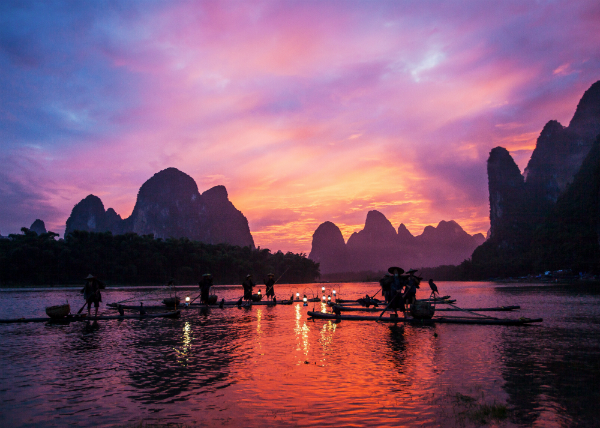
Xingping
Xingping was one of several ancient river towns that we passed during our cruise, including Daxu and Fuli.
The Guilin area’s position as an historic highway between China’s central plains and the south has left a tangible legacy.
The next day we returned to explore Xingping on foot and found a cluster of historic buildings in the town center, including Wushu Temple, which dates back 1800 years and is now a local history museum.
Just round the corner, we stumbled upon another charming temple of Qing dynasty (1644-1911) vintage, devoted to Guan Yu, the God of War. Xingping’s centerpiece though was the broad waterfront with its beautiful views of the Li and Yi rivers
Yangshuo
Our boat finally came to a rest at the idyllic and laid-back county town Yangshuo, where we alighted at the wharf to run a course of bee keepers touting local honey. Our river journey had ended far too quickly.
Perhaps a better choice if you have the time would be to hike a stretch of the river, soaking up the immensity of the landscape and the charm of the villages and rural scenes.
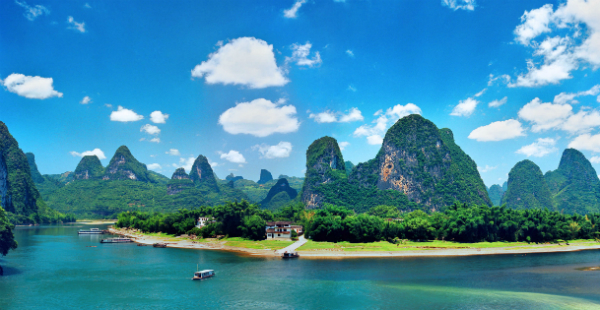
If You Go
How to Reach Guilin
Guilin in southern China is served by Guilin International Airport and the city can also be conveniently reached by high-speed rail from either Shenzhen (next to Hong Kong) or Guangzhou. The journey takes 3.5 hours.
Li River Cruises
Boats with English speaking guides embark daily at 10 am from Zhujiang Pier, a 40-minute drive from downtown Guilin.
Tickets can be scored at Guilin travel agents and hotels for RMB420, including a free shuttle bus to the pier, which picks up from various places around town. Alternatively make your way to the pier by taxi for about RMB100 and buy tickets.
Where to Stay in Yangshuo
Giggling Tree
Aishanmen Village, Yangshuo County
Tel:13661266754
Outstanding rustic hotel outside Yangshuo near some of the best Yulong River cycling routes. The Dutch owners have lovingly created characterful guest rooms inside converted county houses.
Al fresco dining in the courtyard is another draw and the hotel also offers good tourist maps and bike hire.
Where to Eat in Yangshuo
Cloud 9
1 Chengzhong Rd, West Street, Yangshuo County.
Tel:0773-8813686
Classy Sichuanese joint in the middle of the traveler action on West Street which serves up a good spread from all over China.
The Li River Poached Fish is fresh, and the Taro and Pork Stew also comes recommended. Menu options for the adventurous include Dog Hotpot and Bamboo Rat.
Author Bio: Harvey is a Hong Kong-based writer and publisher of Meet China guides. “Must-read guides for history and travel buffs.” Time Out. Harvey has translated Chinese novelists like Murong Xuecun while his own innovative fiction has appeared in journals like Experimental Writing and Tears on the Fence. Guilin: China’s Masterpiece is a comprehensive Guilin and Yangshuo guidebook, with in-depth introductions to scenery, history, local ethnic minorities, and hiking, biking and climbing routes, available now on Amazon and Kindle.
- Top 10 Things to Do in Ireland - April 25, 2024
- How to Get Around in Sydney: A Local’s Guide to Traveling Around Sydney - April 24, 2024
- The Low-Key Magic of Ghent, Belgium - April 22, 2024
